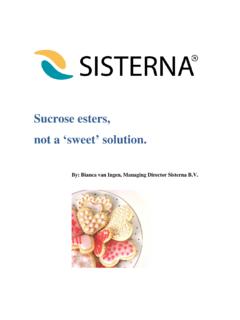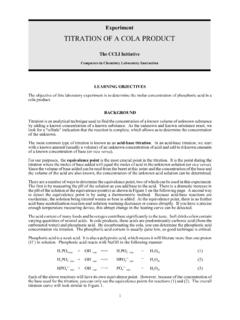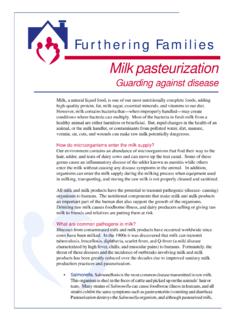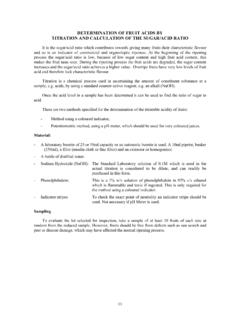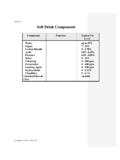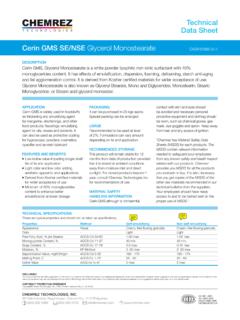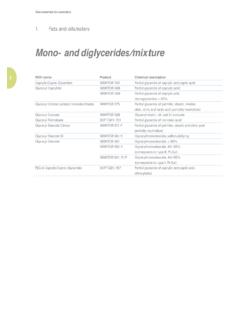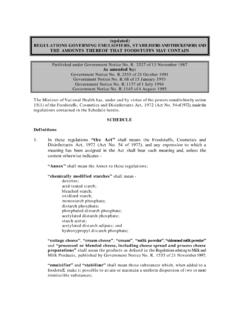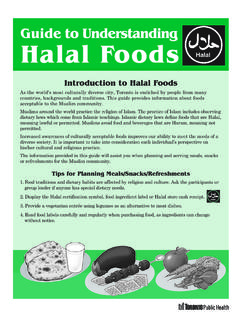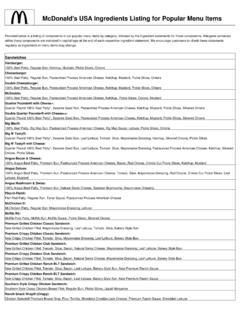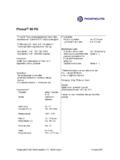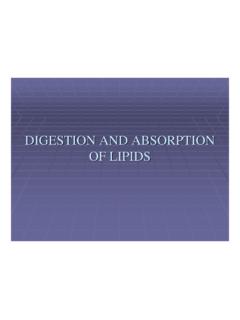Transcription of CAKE EMULSIFIERS - Fantastic Flavours
1 CAKE EMULSIFIERS NEW DEVELOPMENTS- ALPHA CRYSTALLINE GELS DRAFT-AMERICAN SOCIETY OF BAKING MEETING- 2001 Emulsion & EMULSIFIERS Oil and water are immiscible since the interaction results in high energy at the common surface. Through the physical action of mixing one can break up the oil into fine droplets which may be dispersed/ distributed into the water phase (Figure 1) to form a dispersion which may be called a emulsion. An emulsion is an unstable multiphase system containing at least two immiscible liquid phases. When the physical mixing action is stopped the oil droplets will coalesce and the oil and water will again separate into 2 different layers. To stabilize a emulsion, the droplets of the disperse phase must be as small as possible and as widely distributed as possible in the continuous phase. Further the viscosity of the continuous phase must be high to retard coalescence.
2 Ultimately to prevent such coalescing of oil droplets and subsequent layer separation, certain chemicals may be used which are known as EMULSIFIERS . EMULSIFIERS are made up of molecules that have a non-polar (fatty acid) end which carries no charge and haS an affinity for oil and a polar ( glycerol) end which carries a charge and has an affinity for water (Figure 2). Such a molecule can situate itself at the interface between oil and water. The polar end will immerse itself in the aqueous phase and the non-polar end will immerse itself in the lipid phase (Figure 3) and prevent coalescence of the oil droplets. This helps the two phases to stay intimately mixed and form a stable emulsion. Emulsions may be characterized in two ways. In a first instance the oil droplets may be dispersed in the water leading to an oil in water emulsion.
3 If on the other hand the water droplets are dispersed in the oil, then we have what is known as an water in oil emulsion (Figure 4). A foam is also a type of an emulsion where a gas is dispersed in a liquid phase or occasionally a solid phase. The affinity of EMULSIFIERS for either oil or water is measured by the HLB scale. If the HLB of an emulsifier system is between 3-6, it has an oil affinity and such an emulsifier will optimally stabilize a water in oil emulsion. On the other hand a emulsifier with a HLB value of 9-18 has a preference for water and therefore will optimally stabilize a oil in water emulsion. Cake Batter: A cake batter is a complex aerated emulsion of a shortening in an aqueous phase. In high fat batters, the emulsion is aerated by the inclusion of air into the fat phase which in turn is dispersed in the water phase (Figure 5).
4 When the batter temperature rises during baking, shortening melts and the air migrates into the water phase. On the other hand in low/no fat batters like sponge cakes the air is incorporated directly into the aqueous phase at the mixing stage. The ideal aeration depends on both the number and size of the air bubbles in the foam. Proper aeration has to be accompanied by a system to stabilize the air bubbles. In cake batters EMULSIFIERS stabilize the foam by forming a film around the bubbles and preventing coalescence. Improving batter viscosity retards bubble movement which further contributes to foam and batter stability. Aeration combined with emulsification of the oil and water are two essential functions of EMULSIFIERS in cake batter preparation. The optimum emulsifier combination for a cake batter is therefore one that can aerate if needed but more importantly has the ability to stabilize the foam as well as the subsequent fat-water emulsion by it s ability to finely disperse the shortening and help prevent coalescence of the fat dispersed in the water phase.
5 Emulsifier Development The main functions of EMULSIFIERS in the sweet goods sector of the baking industry are: 1. Optimizing distribution of oil in water dispersions and stabilizing the resultant emulsion. 2. Optimizing distribution of air and stabilizing the foam 3. Optimizing internal characteristics. 4. Improving shelf life 5. Optimizing development of reduced fat products 6. Optimizing use of liquid oils with low levels of Trans Fatty Acids As cake baking has become a more precise industrial activity, baking EMULSIFIERS have become a very important class of ingredients in the manufacture of cakes and other sweet goods. In the early days bakers used eggs and lecithin as providers of natural EMULSIFIERS mainly due to the presence of phospholipids that have surface-active properties. In the early 1920 s chemical EMULSIFIERS made their first appearance in the form of mono-diglycerides.
6 A mono-diglyceride is an ester formed when an acid combines with an alcohol. Specifically a mono-diglyceride (Figure 6) is an ester which is formed when the fatty acid is a triglyceride fat which combines with a polyvalent alcohol - glycerol. Mono-diglycerides, the first chemical EMULSIFIERS used in baking, contained about 40-50% of the monoglycerides- the component that is functional as an emulsifier. Subsequently distilled mono-glycerides were developed since such EMULSIFIERS contained 90-95% of the functional monoglyceride (Figure 7). The introduction of monoglycerides helped the cake baker increase the proportion of both fat and sugar in the batter and this resulted in rich, high ratio cakes with superior keeping qualities. As the baking of cakes became more automated and the demands of the market called for cakes and sweet goods with a better quality and longer shelf life, emulsifier technologists developed a wide range of emulsifier products.
7 To address these needs there has been continuing development of EMULSIFIERS and some of the important ones are summarized below: * Long chained, saturated fatty acids have the best starch complexing ability (Figure 8). To increase shelf life of baked goods Glyceryl Mono Stearate (GMS) was made by utilizing saturated long chain stearic acid. Such fatty acids were either derived from animal sources like lard or saturated through hydrogenation of vegetable oils. This saturated acid was then reacted with Glycerol to give GMS with superior anti staling properties. * It was noted that derivatives of monoglycerides with lipophilic tendencies had unique qualities to improve the quality of cake and other baked goods. Some of these products include PGMS (Figure 9) and PGE (Figure 10). PGMS is often used in American sweet goods baking.
8 Another derivative emulsifier is PGE, and it is very commonly used by European craft bakers but to date has been sparingly used by the North American sweet goods baker. Nevertheless it has substantial potential to improve American sweet goods as will be discussed below. Commercial product development of EMULSIFIERS for the baking industry has been predominantly based on the chemical properties of surfactants. In the ongoing search to develop new products, concepts have now been developed based on physical properties of EMULSIFIERS , in particular the crystalline behavior of EMULSIFIERS . Alpha crystalline EMULSIFIERS Monoglycerides are polymorphic since they can exist in 4 crystalline forms- alpha, alpha prime, beta and beta prime (Figure 11). Powdered EMULSIFIERS exist in the beta crystalline form- very stable and moderately functional.
9 The beta crystal is the most rigid and stable at low temperatures. Crystalline emulsifier molecules are oriented with the hydrocarbon chains in dense parallel layers (Figure 12). When heated in the presence of water, the hydrocarbons change from a solid to a liquid state with the water penetrating in between the polar groups of the bi-layers. On cooling the hydrocarbon chains crystallize, forming a sandwich structure of alternating surfactant and aqueous layers giving a alpha crystalline gel phase. The alpha crystal form is known to be much more functional (Figure 13) than the beta crystal. However this alpha gel is unstable and has a tendency to revert back to the beta crystalline form. Researchers have identified many reasons for the superior functionality of the alpha crystalline form. One major reason is that the liquid alpha crystalline form is more flexible than the rigid beta crystalline form and rearranges more easily during heating cycles.
10 Thus alpha crystalline EMULSIFIERS are able to form flexible and more protective films around the dispersed phase be it oil, air or water and preserve the emulsion (Figure 5). At this stage it would be appropriate to clarify the term "alpha" (Figure 14). Occasionally emulsifier specification sheets specify a "alpha-monoglyceride content"- a figure that may be ambiguous. Monoglycerides can have the fatty acid moiety at C-1, such monoglycerides are called 1-monoglyceride, or at C-2 when it is called 2-monoglyceride. A practice has also grown of calling the 1-monoglyceride as _-monoglyceride and the 2-monoglyceride as _-monoglyceride. This practice may be misleading as it relates to the positional isomerism of the emulsifier rather than the critical crystalline structure being discussed here. A traditional and preferred method for the optimum utilization of Monoglycerides has been through hydration.
